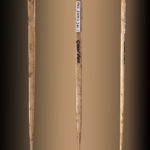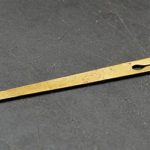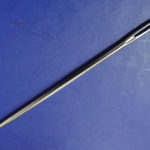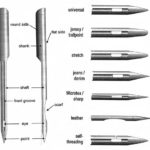
The needle is definitely a unique work of art!! Without the needle, how would we have clothes? Or socks on our feet? How about coats or jackets? Where, how, and who made this tool that makes making our garments, socks, coats, even blankets easier?
The sewing needles were first made from bone or antlers or even wood. Latter versions were mad from nickel, 18K gold plated against corrosion, or high carbon steel.
The best embroidery needle is made from 1/3 titanium alloy and 2/3 platinum.
The earliest needle found was from the Paleolithic Age, around 40,000 years ago, their needles had grooves in place of the “eye” to hold the fibers or sinew, whatever thread they used. They often made their needles from tusks, animal bones or even antlers.
The Ancient Egyptians made the needles out of ceramic and were double pointed with an “eye” at either end. The Romans made theirs from iron and bronze, the “eye” at the top.
It is believed that most needles that were made from bone or horn or antler were smoothed down with sand. Later a stone mill was used to smooth and polish the needles.

Needles were not only used in the sewing field, but also were used in the medical, clock making and the goldsmithing fields as well. In the 17th century, needle makers decided to move from London to Redditch, England to avoid guild restrictions and the industry has remained there ever since.
The needle makers of the 18th century began to develop a system of production that the basis of today’s factories is built from.
The needles that are made from steel, were heated, shaped into a cylinder, and then drawn through a number of dies to achieve the proper gauge, then they were cut to needle lengths. One end was hammered flat so “eye” could be punched and then filed smooth, the other end was sharpened by filing for the point. They were then hardened by heating and cooling, then were tempered for strength and straightened with a hammer and anvil.
They were then put into a bag that was filled with emery dust and olive oil to be polished by being moved back and forth between planks under heavy weights for up two days, then washed in hot water and soap, dried in a bran filled box, then were sorted and repointed with an emery stone by hand.

Workers who were “pointers” had a dangerous job as they held up to 100 needles against the grinding stone. They could finish anywhere around 10,000 needles in an hour!! However, if the grinding stone should break and fly apart, it would have been fatal. But what was considered the most serious danger, was the inhalation of the tiny particles of stone and metal they worked with.
The life expectancy of the workers was under 35 years, they only a guinea a day and avoided the dust exhaust equipment and the mechanization areas. Needles that were packed in France were packed in the rust-inhibitor, asbestos powder, before in was made known that it caused lung cancer.
In the 19th century, the British held dominance in the needle making industry, they were sold all over the world, but largest shipment went to the U.S. And Americans have never even attempted to challenge the British in needle making.
Needles will always be around, whether you use them to sew by hand or with a sewing machine. There are thousands of different kinds of needles, ranging in sizes, shapes and metals.
You have the embroidery needle, which has a long “eye” to make it easier to thread multiple threads or yarn through.
A sharp needle that is used for general sewing, it has a very sharp point, is medium length and has more of a round “eye”, some even have double “eyes”. Great for sewing with two threads.
Then there’s the Quilting or “betweens” that are short and have a small round “eye”. These can make really fine stitches even on heavy duty fabric. Tailors also use the “between” needles. There is a distinct difference between the quilting needles and quilting “between” needles from some manufactures. The quilting “betweens” are somewhat shorter than the narrower somewhat longer quilting needles.
There are also beading needles, doll making needles, darning needles, needles for leather, upholstery, tapestry, sail making, tatting and appliqué. So you have a lot to chose from depending on the type of work your doing.

